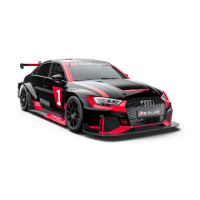
Do you have a question about the Audi RS 3 LMS DSG and is the answer not in the manual?
| Brand | Audi |
|---|---|
| Model | RS 3 LMS DSG |
| Category | Automobile |
| Language | English |
Details about the car's display system, including engine, power transmission, chassis, body, and safety equipment specifications.
Provides comprehensive details on the car's overall dimensions, width, wheelbase, and weight distribution.
Lists part numbers and materials for various body components, from bonnet to diffuser.
Outlines engine specifications such as type, capacity, bore/stroke, output, torque, ECU, and exhaust system.
Details the fuel tank specifications, capacity, minimum fuel level, and refuelling procedures.
Describes the transmission system, including gearbox type and drive-wheel configuration.
Covers chassis details including suspension, brakes, and wheel specifications.
Lists electronic modules, their software, and placement within the car.
Details the main control panel functions, including ignition, lights, blinker, and brake balance.
Explains the electronic steering wheel module and its various button functions and operations.
Describes the speed limiter system, its uses in pit lanes or FCY situations, and activation process.
Explains the car's display alarms and shift lights configuration and their meaning.
Details the different gearbox modes (P, R, N, D, S, Tip) and their operational characteristics.
Explains the launch control system and the recommended procedure for standing starts.
Describes the lever-type proportioning valve for adjusting brake bias and its 7 distinct settings.
Provides essential tips for drivers, including button familiarity, warm-up procedures, and handling warnings.
Explains the AIM dash-logger for acquiring and displaying data from the ECU, sensors, and GPS.
Illustrates data-logger connection schemes for standard setup and with a smarty-cam expansion module.
Lists the AIM-MXG channel list with descriptions, units, and recommended scales for data acquisition.
Details the fusebox, its function, and methods for checking fuse status.
Explains the fuel level display, its operation, and menu navigation using touch zones.
Describes auxiliary connectors in the cockpit for power supply, analog sensors, radio, and drink systems.
Details the transponder auxiliary connector located behind the front headlight, not provided on all cars.
Describes the auxiliary connector for additional headlights and provides two electrical installation solutions.
Covers the OMP fire extinguisher placement, activation, and safety notes for operation.
Provides a detailed standard setup for car configuration, track information, powertrain, transmission, brakes, and alignment.
Explains the procedure for electronically aligning the steering angle sensor with the wheels.
Details the process for adjusting front suspension camber and toe angles for optimal kinematic characteristics.
Outlines the procedure for adjusting rear suspension camber and toe using the boomerang arm and rear arm.
Lists the spring ranges available for front and rear axles, with recommended uses.
Details specifications for front and rear anti-roll bars, including diameter, thickness, and stiffness.
Presents graphs illustrating front spring displacement versus toe distance and camber angle.
Lists master cylinder and push rod options for brake setup and discusses the brake balance bar assembly.
Recommends periodic checks of bodywork fixations, rear wing, and front splitter for aerodynamic integrity.
Explains how to adjust the driving position, covering seat, belts, and net specifications.
Describes the car checks performed before customer delivery, including circuit laps and system checks.
Provides a checklist for post-rebuild or main job verification, using live measures or the car's display.
Explains how to identify the car's VIN and engine number, showing their locations.
Details the specific fluids and quantities required for the engine, gearbox, drive shaft, coolant, brake fluid, and fuel.
Outlines the engine's control routine before start, maintenance procedures, and parts subject to frequent service.
Describes the standard air filter cleaning procedure and parts subject to frequent service.
Details the control routine before start and maintenance for the DSG gearbox, including oil and filter changes.
Explains the VAQ differential, its mappings, and routine maintenance, including oil changes.
Describes the 100I FIA FT3 fuel tank, its pump system, and the refuelling tool.
Details the Krontec airjack system, its placement, and the airlance and car plug dismounted view.
Lists engine parts with inspection, service, and change mileage, along with remarks for each.
Details transmission components like gearbox, diff, and driveshaft with service mileage and remarks.
Specifies mileage for fuel tank components such as pump filter and engine fuel filter, including remarks.
Lists front axle parts like dampers, ball joints, and steering rack with service mileage and remarks.
Details rear axle components like dampers, ball joints, and wheel hubs with service mileage and remarks.